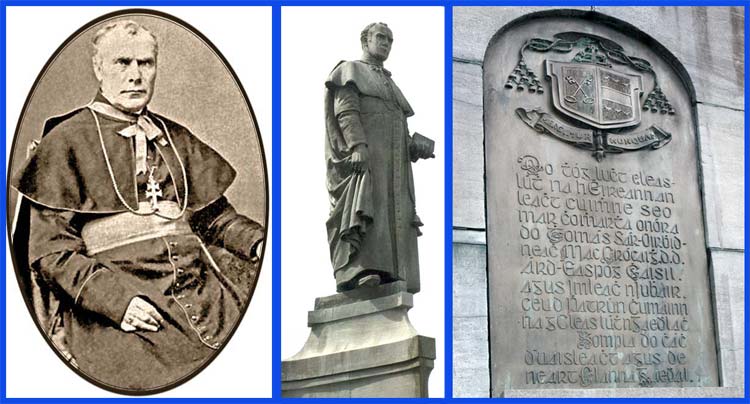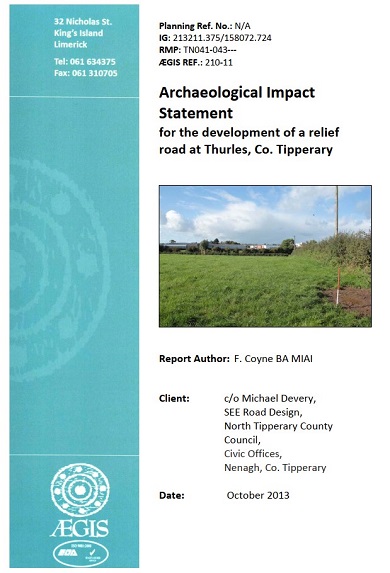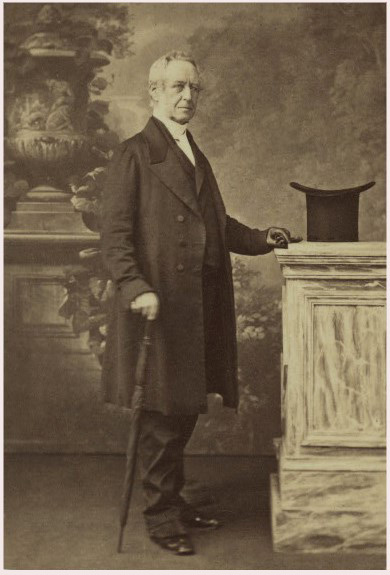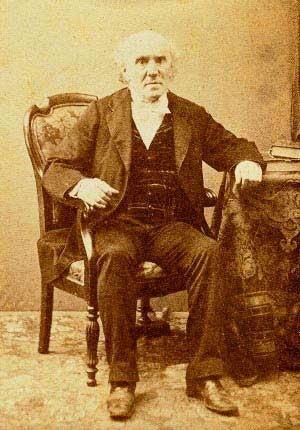
Sunday last, July 22nd 2018 marked the 116 anniversary of the death of Archbishop Thomas William Croke (D.Div.) [28 May 1824 – 22 July 1902], the second Catholic Bishop of Auckland, New Zealand (1870–74) and later to become the Irish Archbishop of Cashel and Emly. A former patron of the Gaelic Athletic Association, with the largest GAA stadium situated in Dublin, Croke Park, named in his honour.
Archbishop Croke was born in Castlecor, Dromin in the parish of Kilbrin, Co. Cork, in 1824. His grandfather was a shopkeeper in the local square. His father, William was Land Agent/Manager for the 4,000 acres Freeman Estate, purchased from the Chinnerys in the early 18th century. (Freemans of Castle Cor, Co. Cork, their home now demolished.).
William his father married a Protestant girl, one Miss Isabella Plummer, daughter of an aristocratic family, latter descendants of the Knight of Glin, a hereditary title held by the FitzGerald families of Co. Limerick, since the early 14th century. Isabella’s parents would disown her following her Roman Catholic marriage to William in 1817.
Archbishop Croke was the third of eight children born of this couple, before his father died in 1834. William’s brother, Reverend Thomas Croke, now took it upon himself to supervise the education and upbringing of the children.
Two of Archbishop Croke’s brothers would enter the priesthood, while two sisters would enter a convent and become nuns. Archbishop Croke himself would go on to be educated in Charleville, Co. Cork and later at the Irish College in Paris and the Irish College in Rome, winning academic distinctions, including a Doctorate of Divinity, with honours.
Ordained a priest of the Cloyne diocese at the height of the ‘Great Famine’ (1845-1849) in May of 1847, he was appointed a Professor in Carlow College. Irish nationalist Member of Parliament (MP) and leader of the Young Ireland movement, William Smith O’Brien claimed that Archbishop Croke fought on the barricades in Paris during the French Revolution in 1848.
In 1858 he became the first president of St. Colman’s College, Fermoy, Co. Cork and then served as both parish priest of Doneraile and Vicar General of Cloyne diocese from 1866 to 1870. Thomas Croke attended the First Vatican Council as theologian to the Bishop of Cloyne in 1870.
In 1870 Croke was appointed Bishop of Auckland in New Zealand, arriving in Auckland on 17th December 1870 on the Steamer “City of Melbourne”. During the next three years as Bishop of Auckland; Croke devoted some of his considerable personal wealth to rebuilding diocesan finances. However, in Auchland there was then little sign of the strongly Irish nationalist line Croke would later adopt following his return here to Ireland; transferred to become a member of the Irish hierarchy as Archbishop of Cashel, (One of the four Catholic Irish archbishoprics, i.e. Cashel & Emly; Dublin; Armagh and Tuam).
Archbishop Croke (His motto – “Mergimur Nurquam”. Literal translation from Latin “We are never sunk”.), would now become a strong supporter of Irish nationalism, aligning himself with the Irish National Land League; an Irish political organisation of the late 19th century which sought to help poor tenant farmers; and with the chairman of the Irish Parliamentary Party, Charles Stewart Parnell, latter a wealthy and powerful Anglo-Irish Protestant landowner. Croke’s support of nationalism caused successive British governments and the Lord Lieutenant of Ireland’s civil service in Dublin to be deeply suspicious of his known associations. He also associated himself with the Temperance Movement of Irish Catholic priest and teetotal reformer, Father Theobald Mathew, [latter born at Thomastown, near Golden, Co. Tipperary, on October 10th, 1790], and the Gaelic League from its foundation in 1893; its aim to restore the Irish language.
Later, somewhat embarrassed by Charles Stewart Parnell’s immorality, Archbishop Croke was forced to distance himself and withdrew from active participation in nationalist politics, following the scandal that erupted over Parnell’s relationship with Mrs Katherine (Kitty) O’Shea, (particularly during the period 1886-1890), latter the separated wife of Parnell’s fellow M.P., Captain William (Willie ) O’Shea. Captain O’Shea would eventually file for divorce from his wife, citing Charles Stewart Parnell as co-respondent. A two-day trial would reveal that Mr Parnell had been the long-term lover of Mrs O’Shea and had indeed fathered three of her children. This scandal back then would force the two dominant forces of Nationalism and Catholicism to split wide apart.
Due to his support and known association with Parnell’s efforts, Archbishop Croke now found himself summoned to Rome by Pope Leo XIII and Cardinal Simeoni. Following his meeting and prior to his return to Ireland, he stayed over at the Irish College in Rome and when questioned regarding the outcome of his meeting with both men, Archbishop Croke stated that he returned to Ireland “Unchanged and unchangeable.”
Archbishop Croke died at the Archbishop’s Palace in Thurles, Co. Tipperary on 22nd July 1902, aged 78 years and he is buried in the Cathedral of the Assumption, Thurles, Co. Tipperary.
Today: From the western side and overlooking Liberty Square, in the centre of Thurles, Co. Tipperary, a very fine life sized statue of Archbishop Thomas William Croke (D.Div.) exists bearing the Irish inscription:-

Translation: The Athletic Association of Ireland erected this commemorative plaque as a tribute of honour to the Most Reverend Thomas Croke, D.D., Archbishop of Cashel and Emly, the first Patron of the Gaelic Athletic Association.
An example to every one of the nobility and strength of the Irish People.




